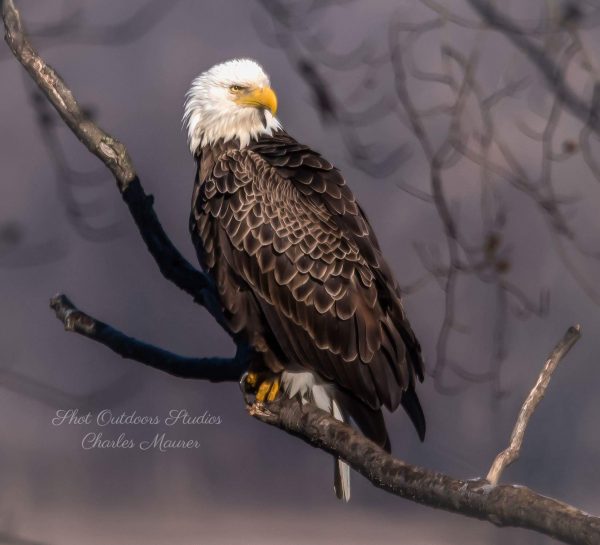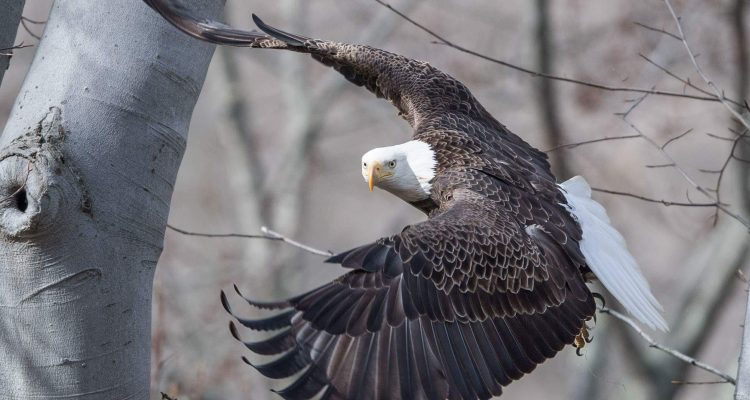The first time I saw a bald eagle here in the Ohio Valley, I had to blink to be sure I was awake. I was born in the late 1970s when eagles were still a rare treasure, a bird you might see out in a western national park or down in the Everglades. In the minds of most adults, bald eagles are the poster-child for the Endangered Species Act.
In the 18th century, bald eagles numbered nearly half a million. One hundred years later, populations plummeted due to use of the pesticide DDT. Some birds became sterile, while others laid eggs so fragile they broke under the weight of their parents’ bodies. In the 1950s, only 412 nesting pairs remained in the lower United States. We almost lost the eagle.
The bald eagle was listed as an endangered species in 1967, and DDT was banned shortly thereafter. The Endangered Species Act was passed in 1973, and the eagles were in it. Since then, eagle populations have rebounded, but it didn’t happen overnight. Perhaps that’s why the sight of our national bird — a species that, now, might be the poster-child for ecological success stories — thrills us the way it does, despite the fact that they’ve been here for well over a decade.
I asked local friends: Where have you seen a bald eagle lately? The answers flooded back: Brilliant, North Wheeling, New Martinsville, Shadyside, Bellaire, Tappan Lake, Piedmont Lake, Oglebay, Canonsburg Lake. Eagles, it turns out, are everywhere.
Dr. Laura Kearns is a biologist with the Ohio Division of Wildlife. While she was eager to chat about bald eagle populations, she surprised me when she said Ohio is so full of eagles they no longer monitor each nest.
“Here in Ohio, we don’t really do much with eagles anymore, except, you know, what the public reports to us,” Kearns said. “We do population estimates. We do that based on eagle nests, but we don’t really do it based on the numbers of eagles per se. The eagles are a thriving species in our region. We have scaled back our survey efforts.” Instead, the Division of Wildlife bases their estimates on a sample area because there are so many birds in Ohio.
“We’ve estimated over 220 eagle nests as of last year,” Kearns said, “and there’s likely more than that.”
She said the state of Ohio was down to four nesting pairs of eagles in the late 1970s. That was when the Division of Wildlife began fostering eaglets in nests and rehabilitating eagles. In the mid-1990s, there were still only 20-some nests, but by the early 2000s, the population began to expand. Federally de-listed in 2007 and de-listed by the state of Ohio in 2012, the population grew exponentially in the first decade of the new millennium. Though officials still rehabilitate eagles, the number of nests fluctuates between 175 and 220. Finally, Ohio has a healthy population of birds.

Wildlife photographer Chuck Maurer agrees. He lives in Shadyside and doesn’t consider himself a professional, but anyone who follows his Facebook feed might disagree: his nature photos are spectacular. What began as a hobby has become his passion. He sells prints and frames them, too, and he knows where to find all the eagle nests in our area.
Maurer confirmed what Dr. Kearns told me: the eagles aren’t just back — they’re flourishing.
“All of our man-made lakes around here and reservoirs, they’ve all got eagles on them,” Maurer said. “I have pictures of eagles on every lake and reservoir around here, including the Ohio River.”
He first spotted a bald eagle in 2006 and began taking pictures with a Canon point-and-shoot. In the following years, he saw a pair of birds between Bellaire and Shadyside and observed them as they built a nest. He named these Shadyside eagles “Orange” and “Black.” This pair reared their young in the same nest for several years. Last fall the nest came down in the weather, but as Maurer told me, eagles are notorious for rebuilding in the same place. His birds did just that, only to abandon the nest this winter before nesting season. Maurer said the pair wasn’t as well adapted to humans as some other eagles, and he decided to leave them alone rather than put undue stress on the reproducing birds.
Many other pairs live in our area, and Maurer visits nests several days a week. He initially discovers a nest by following a bird carrying nesting material.
“I follow eagles all the way up and down the Ohio River Valley and into Pennsylvania, my favorite being in Newcomerstown on the Tuscarawas River. Those are everybody’s favorite. There’s a nest you can photograph within 70 yards, and you’re looking down in it.” Currently, eagles in our area are incubating eggs. Of particular interest to wildlife photographers right now is what’s known as the changing of the guard. Before the chicks hatch, the parents take turns incubating the eggs for 34-36 days. One bird sits, keeping the eggs at a toasty 105 degrees and rolling them over periodically, while the other goes fishing or perches nearby to protect the nest. Then they trade places. During this changing of the guard, photographers can capture some stunning images.
Maurer knows almost to the day when some of the chicks will emerge and plans to continue photographing all of our area’s new eaglets as they grow and fledge in early summer.
Maurer isn’t the Ohio Valley’s only expert eagle-watcher. On the West Virginia side of the river, Dr. Albert “Jay” Buckelew of the Bethany College biology department is a leading bird expert. He’s also a member of the statewide Brooks Bird Club. In addition to studying common mergansers that have recently arrived in our area, as well as a never-before-seen raven nest in Bethany, Buckelew and the bird club are keeping tabs on local eagles in Brooke County.
“We visited a bald eagle on its nest on a tributary to the Buffalo Creek,” he said. “It’s always a thrill to see an eagle on its nest only a couple of miles from your house. Who would ever have thought?”
Unlike its Ohio counterpart, the West Virginia Division of Wildlife still monitors its eagles. The first nest was discovered in Hampshire County in 1981. By 2000, the state maintained a growing population of birds.
Of the Buffalo Creek eagles, Buckelew said, “This is the fifth year that that bird’s been on its nest. They keep the same nest year after year if it’s not disturbed. The nest is still there, and it’s still occupied.” Buckelew said there’s likely another nest near Casselman Run Lake and knows of yet another across the state line of Pennsylvania.
“They truly are everywhere there’s food,” he said. “They need a body of water where they can catch fish.” They don’t actually have to catch the fish, though; eagles work smarter, not harder. They’re perfectly happy to steal from other raptors like ospreys. In fact, when eagles thrive, osprey numbers tend to decline.
Buckelew cited the old story about Benjamin Franklin’s push to make the turkey our country’s national bird because it better embodied what the early United States stood for.
“Turkeys are industrious and work hard whereas bald eagles are kind of lazy,” Buckelew said. Additionally, he reported that, on any winter day at the locks and dam in Newell, West Virginia, you can spot a clever eagle perched along the shoreline.
“Up in Newell, there’s one that sits right there on the downstream side of the dam and waits for fish to be killed as they go through the dam. And he just flies down and picks up a dead or injured fish. That’s how he fishes all day long.”
When it comes to eagle-spotting, most people look for the telltale markings: the white head and tail feathers. But you may have seen an eagle and not realized what you were looking at.
“I think there’s really more around than people even think,” said Buckelew. “Bald eagles don’t get that distinctive black color with the strikingly contrasting white head and white tail and the yellow bill until they’re three years old. It takes them three years to mature so they can nest and they get that beautiful black and white color.”
Bald eagles have made a remarkable comeback in our area and all across America. If you’re interested in following the birds this nesting season, you can get in touch with the Brooks Bird Club. You can also check out Chuck Maurer’s social media feed for the arrival of Ohio Valley eaglets. Or, thanks to years of hard work and rehabilitation efforts by wildlife officials, you can simply head out to your nearest body of water and have a seat. Eventually, the eagles will find you.
Photos provided by Chuck Maurer.
• Laura Jackson Roberts is a freelance writer in Wheeling, W.Va. She holds an MFA in Creative Writing from Chatham University and writes about nature and the environment. Her work has recently appeared in Brain, Child Magazine, Vandaleer, Animal, Matador Network, Defenestration, The Higgs Weldon and the Erma Bombeck humor site. Laura is the Northern Panhandle representative for West Virginia Writers, a blog editor for Literary Mama Magazine and a member of Ohio Valley Writers. She recently finished her first book of humor. Laura lives in Wheeling with her husband and their sons. Visit her online at www.laurajacksonroberts.com.




